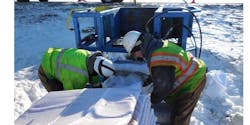Finding a Cure
Southwestern Minnesota is a rural area with limited roadway infrastructure, so when there is work to be done to adjacent storm water piping, it is especially critical that the technology used to renew the pipe does not hinder traffic.
Hugo, Minn.-based underground contractor Lametti & Sons used Inliner Technologies’ method of cured-in-place pipe (CIPP) to renew approximately 5,000 ft of pipe over 62 culvert segments for the Minnesota Department of Transportation (MnDOT). The project began in October 2014 and was completed in December 2014, with a value of approximately $660,000.
The project area encompassed five state highways within six counties in southwestern Minnesota. The installations primarily took place adjacent to rural farmland. Many of these reinforced concrete culverts were highly deteriorated due to age, exposure to the weather elements and heavy loads from the highways above.
The pipe ranged from 24 to 36 in. in diameter, with segments ranging from 50 to 120 ft long.
Maintaining traffic flow was the primary challenge for these projects, as the trucks and equipment were staged on the highway shoulders, some of which were narrow two-lane roads. Flaggers were needed to safely direct traffic around many of the installation sites.
“In these rural areas, there are limited transportation options, and closing the highway in many cases is not an option,” said Brett Anderson, Lametti project manager. “Cured-in-place pipe is the ideal solution for renewing these culverts without impacting traffic flow.”
Winter's Hold
With winter taking an early hold on the Midwest, several of the installations were delayed due to heavy snowfall. Although CIPP can be successfully installed in severe weather, because traffic and crew safety issues were in play, the projects were rescheduled.
CIPP technology allows for the rehabilitation of damaged underground wastewater and storm sewer pipes without excavation. The process minimizes disruption to the public by reducing noise, traffic disturbance and road damage—and can be done within a far shorter time frame, and usually for less cost than replacement. With Inliner CIPP, a felt tube saturated with resin is inserted into the pipe via inversion or the pulled-in-placed method of installation. Hot water or steam then is circulated through the installed tube to cure the resin. This creates a new “pipe inside a pipe” and is designed to provide the conduit with a minimum 50-year service life.
For the MnDOT installations, the pipe was cured with steam. Due to the remote location of the projects and lack of access to water hookups, it was not feasible to transport large amounts of water along the great distances between the installations. The steam process used a minimal amount of water, which Lametti was able to secure from municipalities along the way.
“We are experiencing a large amount of growth in the culvert lining segment, as Inliner has expanded its capabilities with steam lining,” said Geoff Yothers, director of Inliner Technologies. “We now have the experience, technology and equipment that has allowed us to consider and apply our steam-cured CIPP method in culvert sizes ranging all the way up to 96 in. in diameter.”
Midwest Contracting LLC was the prime contractor and was responsible for sliplining and extending additional culverts in the project boundaries.


